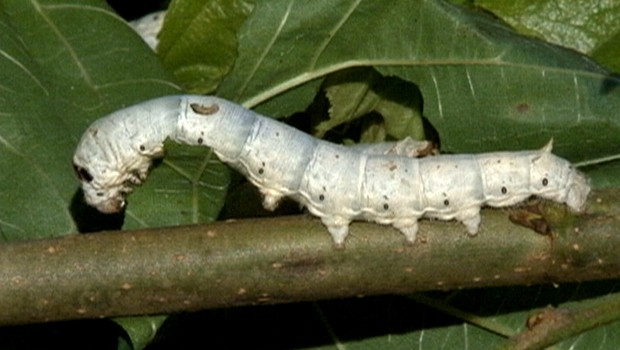Sericulture, or sericulture, is an ancient art that began in China about 5 years ago. It comprises the cultivation of the mulberry tree, the creation of the silkworm and the production of silk threads for the textile industry. It is considered one of the oldest agro-industrial activities practiced by man.
The caterpillar of the Bombyx mori species, known as the silkworm, is an insect with great economic importance, since its cocoons are used in the manufacture of silk and about 95% of the silk produced in the world comes from this species.
This insect is fully domesticated due to the strong genetic manipulation to which it was subjected, in order to obtain a good silk-producing species.
The life cycle begins in the egg, which measures approximately 1 to 1,3 millimeters, being oval and flattened. After laying, it has a yellow color, if fertilized it will turn gray. The larval cycle lasts about 24 days and goes from the hatching of the egg to the phase of cocoon formation. At this stage, the caterpillar feeds exclusively on mulberry leaves, which are also native to China.
The caterpillar when it comes out of the egg grows a lot and needs to change its chitinous exoskeleton. This exchange is called molting, with four skin molts occurring, in which the caterpillar stops feeding. The period of time between skin moults is called age or instar, the larva passing from hatching to cocoon formation by five ages.
The caterpillar in the fifth age is seven centimeters in length and the most developed organ is the sericigenous gland. At the end of this age, the caterpillar weaves a silk cocoon, consisting mainly of the proteins fibroin and sericin, which are produced by the cells of the silk gland and expelled through the mouth. The mechanism of silk thread formation in the sericogenic glands is unique and has been extensively studied.
Cocoons have different colors and different shapes, depending on the races to which they belong. There is a preference for white cocoons because they are easier to dye.
Inside the cocoon, the body of the caterpillar transforms, forming the pupa or chrysalis. The transformation process continues until the formation of the adult individual, the butterfly. This stage lasts about 10 days.
To get out of the cocoon, the butterfly releases an alkaline liquid that corrodes one of the ends of the cocoon, opening an opening for its exit. In this stage, with a duration of 10 to 16 days, the insect does not feed and it is at this stage that it is dedicated to the reproduction of the species. After mating, the female lays 200 to 500 eggs and, like the male, dies.
Authors: Ana Paiva, Clotilde Nogueira and Marisa Rodrigues, Centro Ciência Viva de Bragança
Ana Paiva has a degree in Forestry Engineering, responsible for monitoring, executing, guiding, instructing and monitoring visits to the exhibitions and activities of the Centro Ciência Viva de Bragança (CCVB), in addition to developing strategies that promote a lasting and innovative relationship between public with the CCVB and its activities. Author of several action plans and activities aimed at educational projects.





















Comments